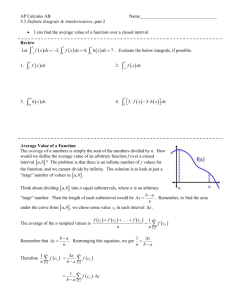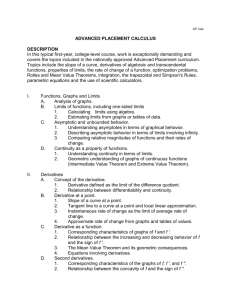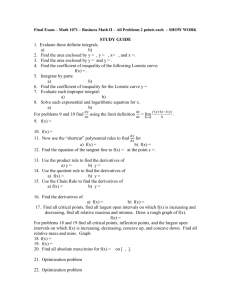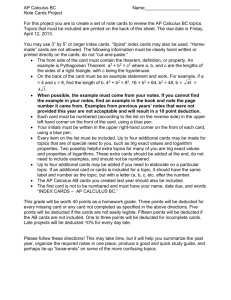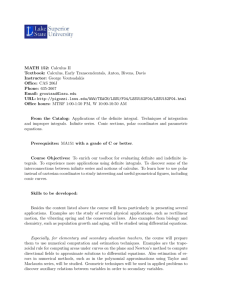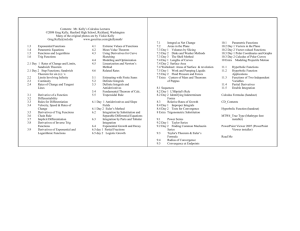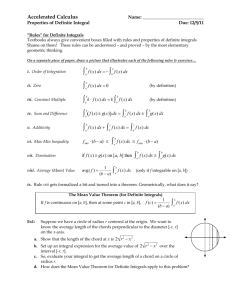AP Calculus BC - Lindbergh School District
advertisement
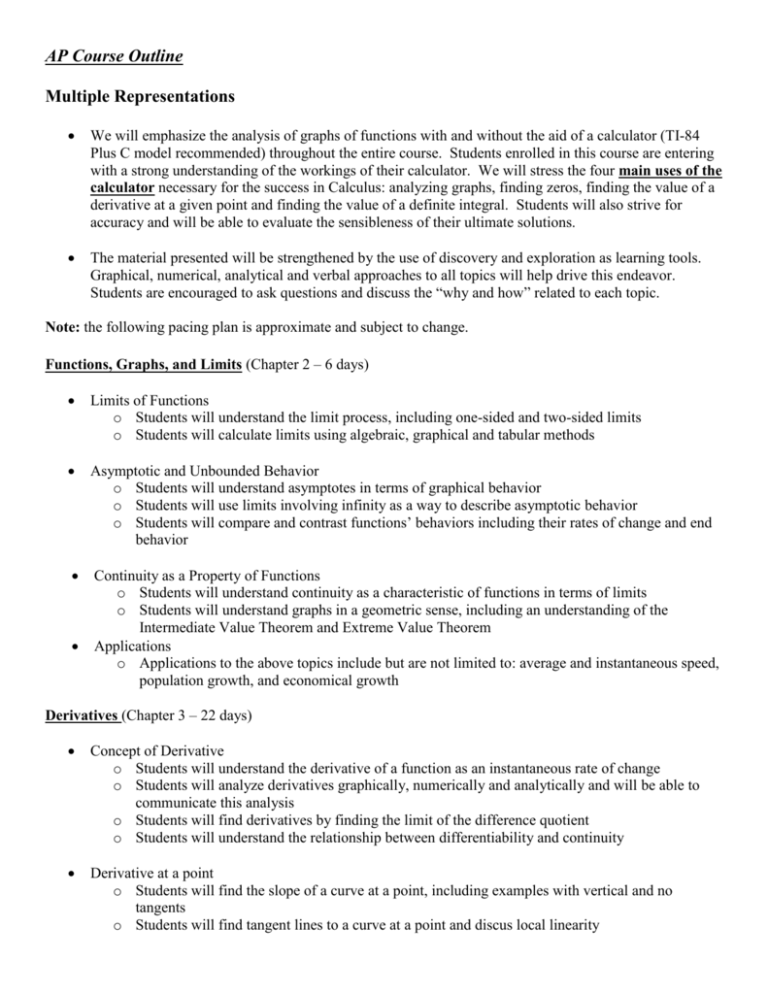
AP Course Outline Multiple Representations We will emphasize the analysis of graphs of functions with and without the aid of a calculator (TI-84 Plus C model recommended) throughout the entire course. Students enrolled in this course are entering with a strong understanding of the workings of their calculator. We will stress the four main uses of the calculator necessary for the success in Calculus: analyzing graphs, finding zeros, finding the value of a derivative at a given point and finding the value of a definite integral. Students will also strive for accuracy and will be able to evaluate the sensibleness of their ultimate solutions. The material presented will be strengthened by the use of discovery and exploration as learning tools. Graphical, numerical, analytical and verbal approaches to all topics will help drive this endeavor. Students are encouraged to ask questions and discuss the “why and how” related to each topic. Note: the following pacing plan is approximate and subject to change. Functions, Graphs, and Limits (Chapter 2 – 6 days) Limits of Functions o Students will understand the limit process, including one-sided and two-sided limits o Students will calculate limits using algebraic, graphical and tabular methods Asymptotic and Unbounded Behavior o Students will understand asymptotes in terms of graphical behavior o Students will use limits involving infinity as a way to describe asymptotic behavior o Students will compare and contrast functions’ behaviors including their rates of change and end behavior Continuity as a Property of Functions o Students will understand continuity as a characteristic of functions in terms of limits o Students will understand graphs in a geometric sense, including an understanding of the Intermediate Value Theorem and Extreme Value Theorem Applications o Applications to the above topics include but are not limited to: average and instantaneous speed, population growth, and economical growth Derivatives (Chapter 3 – 22 days) Concept of Derivative o Students will understand the derivative of a function as an instantaneous rate of change o Students will analyze derivatives graphically, numerically and analytically and will be able to communicate this analysis o Students will find derivatives by finding the limit of the difference quotient o Students will understand the relationship between differentiability and continuity Derivative at a point o Students will find the slope of a curve at a point, including examples with vertical and no tangents o Students will find tangent lines to a curve at a point and discus local linearity o Students will find instantaneous rates of change as the limit of average rate of change and approximate this from graphs and tables of values Derivative as a Function o Students will relate the corresponding characteristics of graphs of f , f’ and f’’ o Students will discover the relationship between the increasing and decreasing behavior of f and the sign of f’. Also, the relationship between the concavity of f and the sign of f’’. Points of inflection are places where concavity changes. o Students will analyze equations involving derivatives. Students will translate verbal descriptions into equations involving derivatives and vice versa. Computation of Derivatives o Students will discover and understand derivatives of basic functions, including power, exponential, logarithmic, trigonometric, and inverse trigonometric functions o Students will discover and understand basic rules for the derivative of sums, products and quotients and will be able to apply the chain rule and find derivatives implicitly, including inverse functions o Students will extend this knowledge to second derivatives Applications o Applications to the above topics include but are not limited to: velocity and acceleration, revenue, spread of disease, frequency of vibrations, and vertical and horizontal motion Applications of Derivatives (Chapter 4 – 14 days) Extreme Values of Functions o Students will find and understand the significance of absolute extreme values and relative extreme values, including the Extreme Value Theorem Mean Value Theorem o Students will explore and apply the Mean Value Theorem o Students will extend the Mean Value Theorem to the analysis of increasing, decreasing and constant functions and to antidifferentiation Modeling and Optimization o Students will use their knowledge of derivatives to model and optimize various situations o Applications to the above topics include but are not limited to: optimization of areas and volumes, maximum profit, minimizing costs, vertical motion o Students will model rates of change, including related rates problems The Definite Integral (Chapter 5 – 16 days) Interpretations and Properties of Definite Integrals o Students will understand definite integrals as a limit of Riemann sums o Students will understand definite integral of the rate of change of a quantity over quantity over an interval interpreted as the change of the quantity over the interval: b f ' ( x)dx f (b) f (a) a o Students will explore basic properties of definite integrals including additivity and linearity Fundamental Theorem of Calculus o Students will use the Fundamental Theorem to evaluate definite integrals o Students will use the Fundamental Theorem to represent a particular antiderivative and the analytical and graphical analysis of functions so defined Techniques of Antidifferentiation o Students will find antiderivatives directly from derivatives of basic functions o Students will find specific antiderivatives using initial conditions o Students will apply this knowledge to various situations such as modeling motion along a line Numerical Approximations to Definite Integrals o Students will use Riemann sums (using left, right and midpoint evaluation points) and trapezoidal sums to approximate definite integrals of functions represented algebraically, graphically and by tables of values Applications of the above topics include average values of functions, the area under a curve as well as motion. Differential Equations and Mathematical Modeling (Chapter 6 – 22 days) Antiderivatives, Slope Fields and Differential Equations o Students will interpret differential equations via slope fields and the relationship between slope fields and solution curves for differential equations o Students will find indefinite integrals analytically o Students will find antiderivatives by substitution, integration by parts and simple partial fractions o Students will solve separable differential equations and use them to model o Students will apply the above topics to exponential and logistic growth and solving exponential and logistic differential equations o Students will use Euler’s method to find numerical solutions to differential equations Applications of Definite Integrals (Chapter 7 – 15 days) Students will apply definite integrals including: integral as net change, areas between curves, volumes of solids, and lengths of curves L’Hospital’s Rule and Improper Integrals (Chapter 8 – 7 days) L’Hospital’s Rule (This topic will be presented after Ch. 3) o Students will explore L’Hospital’s Rule and use it to determine limits and convergence of improper integrals and series o Students will use limits to explore the rate of a function’s growth Improper Integrals (This topic will be presented after Ch. 7) o Students will use limits to evaluate improper integrals o Students will explore infinite areas and volumes Infinite Series (Chapter 9 – 23 days) Concept of Series o Students will explore series as a sequence of partial sums, and convergence of a series as defined in terms of the limit of the sequence of partial sums o Students will use graphing calculators specifically to explore the concepts presented in this chapter Series of Constants o Students will analyze geometric series, harmonic series and alternating series o Students will find error bounds for approximations made from series o Students will examine terms of series as areas of rectangles and their relationship to improper integrals, including the integral test and its use in testing the convergence of p-series o Students will use a variety of tests to determine convergence such as the ratio test, direct comparison test, and alternating series test o Students will apply series to various topics such as decimal expansion, motion and geometric concepts Taylor Series o Students will use explore Taylor polynomials as approximation and gain an understanding of the topic through a graphical demonstration of convergence o Students will explore and develop Maclaurin series and the general Taylor series centered at x = a 1 o Students will generate Maclaurin series for various functions such as e x , sin x , cos x , and 1 x o Students will manipulate Taylor series and develop shortcuts to computing these including substitution, differentiation, antidifferentiation and the formation f new series from known series o Students will define functions as power series o Students will find the radius and interval of convergence of power series o Students will apply the Lagrange error bound for Taylor polynomials Parametric, Vector and Polar Functions (Chapter 10 – 16 days) Planar Curves Presented in Parametric Form, Vector Form and Polar Form o Students will analyze curves given in these forms o Students will find derivatives of functions given in these forms o Students will apply these ideas to projectile motion, velocity and acceleration o Students will find areas of regions bounded by polar curves These topics will be presented twice, once after Ch. 3 (covering differentiation in connection with these types of functions) and once after Ch. 7 (covering integration in connection with these types of functions).
